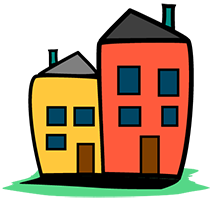So, you’ve identified home usability problems in your home and some solutions but how do you actually go about making that change!?
Setting a Home Usability Goal
Setting SMART Home Usability Goals is a useful strategy for simplifying the home usability process. SMART goals help you break down the process into smaller more manageable steps.
Home Usability Program plan. This worksheet will help you track you home usability problems, set home usability goals, and identify resources. There is even a tracking sheet that will help you set objectives, assign tasks and set deadlines. If you want, you can work with the Community Living Specialist at your Center for Independent Living to complete the work plan.
Identifying Resources
Perhaps the most important step in making a home usability change in your home is identifying the resources available to you. These resources may be personal, like friends and family who can help, or community based, like a local repair service or social program.
Your local Center for Independent Living (CIL) will likely have a list of local community resources. Work with a CIL specialist to identify both your own personal resources as well as the appropriate community resources. Here is a list of national organizations (link to community organizations to support home usability), some of which may have local chapters!
Some things to consider. The following questions are some things to consider when working on your home usability goal. Responses to these questions may help determine whether or not you are eligible for certain community resources. For example, veterans may be eligible for home modification funds through the VA. Review your answers to these questions with your CIL specialist to help identify appropriate resources.
- Home Depot – (National) The Home Depot Foundation has a mission to improve the homes and lives of U.S military veterans and their families. They do not work directly with individuals but instead work with organizations that either help veterans specifically or make a community impact.
- Veterans Affairs – (National) Veterans Affairs is a government run organization that oversees the care and services of veterans. They do not offer any volunteer work but can help with compensation for disabilities, sexual / personal trauma, or employability related to a war or an injury that occurred while serving in the military.
- The American Red Cross provides financial assistance for eligible active military service members, veterans, and direct members of their families. If you became disabled while on duty, this organization may help you in effectively updating your home to meet your new needs.
- 1915(c) Home and Community-Based Services Waiver. If the State has included home or environmental modifications as a waiver service this service is available to persons enrolled in the waiver and who need modifications to their living environment to move to or remain in the community. Exactly what modifications will be reimbursed depends on how the State has crafted the service definition.
- 1915(i) Home and Community-Based Service State Plan Option. The recent changes made to 1915(i) as part of the Affordable Care Act permit States to include, at their option, the same types of services that were previously only available through a waiver. This would include home or environmental modifications if the State has designed their 1915(i) benefit to include such services.
Funding Home Usability Projects
Identifying strategies to pay for home usability projects is often the largest barrier people face when working on home usability. This is why it is important to spend some time identifying what resources are available to you.
Personal resources: financial or material contributions and personal connections (such as family and friends) that can help you achieve your home usability goal.
- Are you able to contribute to the costs of the project? What is your budget?
- Do you have family or friends who can help with building or installation? This can help save on labor costs for more extensive modification projects!
Funding resources: Here is a list of resources that may help help pay for home usability changes. Many of these resources may have eligibility requirements (such as receiving a medicaid waiver or being a veteran). Review this list with your local CIL specialist to see if any of these are right for you! (link to funding resources sheet)
